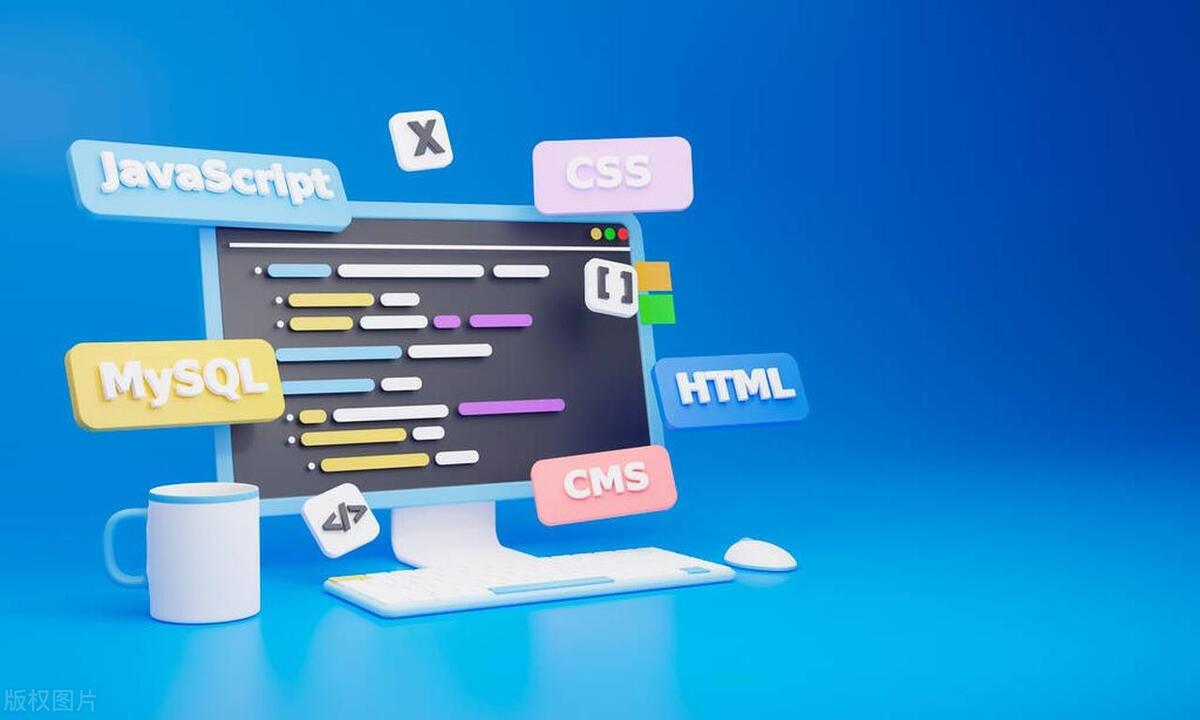WebGL is a JavaScript API that allows hardware-accelerated 2D and 3D graphics rendering in the browser. It is based on OpenGL ES 2.0 and can use the GPU to achieve high-performance graphics processing without plug-ins. It is suitable for applications such as gaming, data visualization and interactive animation. The reasons why the front-end uses it include: 1. Supports cross-platform operation; 2. No additional plug-ins are required; 3. It can be combined with HTML/CSS/JS to build a complete interactive experience; 4. There are rich libraries to support such as Three.js, Babylon.js, etc. To start creating a 3D scene with WebGL, the basic steps are: get canvas and initialize the context; write and compile the shader; link the program; set the buffer to pass in vertex data; configure the viewport and projection parameters; and finally render the scene. Common recommendation libraries include: Three.js (suitable for rapid development), Babylon.js (suitable for gaming), A-Frame (suitable for WebVR), and PixiJS (suitable for 2D). Common problems during development include difficult performance optimization, compatibility issues, debugging difficulties, and slow model loading. It is recommended to solve them by reducing draw calls, testing multiple browsers, checking compilation status, and using glTF format models. It is also recommended that beginners start from Three.js to learn in depth.

WebGL is a key technology for achieving high-performance 3D graphics rendering in front-end development, and is especially suitable for directly running complex graphics applications in the browser, such as games, data visualization and interactive animation. It is based on OpenGL ES 2.0 and can directly operate the GPU to draw graphics without any plug-ins.

What is WebGL? Why does the front-end use it to do 3D?
WebGL (Web Graphics Library) is a JavaScript API that allows developers to perform hardware-accelerated 2D and 3D graphics rendering on web pages. Unlike traditional Canvas 2D, WebGL utilizes users' graphics card resources to make complex graphics processing efficient.
The reason why the front-end uses WebGL to do 3D is mainly because it:

- Supports cross-platform and can run in mainstream browsers;
- No additional plug-ins are required;
- You can combine HTML/CSS/JS to build a complete interactive experience;
- There are rich library support (such as Three.js, Babylon.js), which lowers the development threshold.
How to start creating 3D scenes with WebGL?
To write a WebGL program from scratch, you need to master basic shader language (GLSL), matrix operations, and graph pipeline knowledge. However, in most cases, it is recommended to use encapsulated libraries to simplify the process.
If you decide to do it yourself, the general steps are as follows:

- Get the canvas element and initialize the WebGL context;
- Write vertex and fragment shader code;
- Link shader compiled into a program;
- Set the buffer and pass in vertex data;
- Set parameters such as viewport, projection matrix, etc.
- Render the scene.
Of course, this is just a basic process. In actual development, it also needs to deal with lighting, texture, camera control and other aspects.
What are the recommended WebGL libraries?
Although native WebGL is powerful, the learning curve is steep. For most projects, using mature libraries will be more efficient. Here are several commonly used WebGL libraries:
- Three.js : One of the most popular WebGL libraries, full documentation and active community, suitable for quickly building 3D scenes.
- Babylon.js : Maintained by Microsoft, with a built-in physics engine and editor, suitable for game development.
- A-Frame : HTML-based framework, suitable for building WebVR projects, with simple and intuitive syntax.
- PixiJS : It is mainly used for 2D rendering, but also supports some 3D effects and has excellent performance.
Most of these libraries offer ready-made cameras, lighting, materials and model loaders, allowing you to focus on logic and interactive design.
Common problems and solutions during development
Some common questions when developing with WebGL include:
- Difficulty in performance optimization : Especially on mobile devices, pay attention to reducing draw calls, merging geometry, and using texture compression reasonably.
- Compatibility issues : Different browsers have slightly different support for WebGL, and the mainstream browsers must be covered during testing.
- Debugging is difficult : WebGL error message is usually unfriendly, and you can check it by checking the compilation status of the shader, checking the GPU usage status, etc.
- Slow model loading : It is recommended to use glTF format model, which is small in size, fast in loading, and is widely supported.
In addition, if you are a beginner, it is recommended to start with Three.js, learn and practice, and gradually deepen the underlying principles.
Basically that's it. WebGL is a powerful but detailed technology that may feel a little difficult at first, but once you master the core concept, you can create cool 3D effects.
The above is the detailed content of Frontend Development with WebGL for 3D Graphics. For more information, please follow other related articles on the PHP Chinese website!

Hot AI Tools

Undress AI Tool
Undress images for free

Undresser.AI Undress
AI-powered app for creating realistic nude photos

AI Clothes Remover
Online AI tool for removing clothes from photos.

Clothoff.io
AI clothes remover

Video Face Swap
Swap faces in any video effortlessly with our completely free AI face swap tool!

Hot Article

Hot Tools

Notepad++7.3.1
Easy-to-use and free code editor

SublimeText3 Chinese version
Chinese version, very easy to use

Zend Studio 13.0.1
Powerful PHP integrated development environment

Dreamweaver CS6
Visual web development tools

SublimeText3 Mac version
God-level code editing software (SublimeText3)
 How does React handle focus management and accessibility?
Jul 08, 2025 am 02:34 AM
How does React handle focus management and accessibility?
Jul 08, 2025 am 02:34 AM
React itself does not directly manage focus or accessibility, but provides tools to effectively deal with these issues. 1. Use Refs to programmatically manage focus, such as setting element focus through useRef; 2. Use ARIA attributes to improve accessibility, such as defining the structure and state of tab components; 3. Pay attention to keyboard navigation to ensure that the focus logic in components such as modal boxes is clear; 4. Try to use native HTML elements to reduce the workload and error risk of custom implementation; 5. React assists accessibility by controlling the DOM and adding ARIA attributes, but the correct use still depends on developers.
 Describe the difference between shallow and full rendering in React testing.
Jul 06, 2025 am 02:32 AM
Describe the difference between shallow and full rendering in React testing.
Jul 06, 2025 am 02:32 AM
Shallowrenderingtestsacomponentinisolation,withoutchildren,whilefullrenderingincludesallchildcomponents.Shallowrenderingisgoodfortestingacomponent’sownlogicandmarkup,offeringfasterexecutionandisolationfromchildbehavior,butlacksfulllifecycleandDOMinte
 What is the significance of the StrictMode component in React?
Jul 06, 2025 am 02:33 AM
What is the significance of the StrictMode component in React?
Jul 06, 2025 am 02:33 AM
StrictMode does not render any visual content in React, but it is very useful during development. Its main function is to help developers identify potential problems, especially those that may cause bugs or unexpected behavior in complex applications. Specifically, it flags unsafe lifecycle methods, recognizes side effects in render functions, and warns about the use of old string refAPI. In addition, it can expose these side effects by intentionally repeating calls to certain functions, thereby prompting developers to move related operations to appropriate locations, such as the useEffect hook. At the same time, it encourages the use of newer ref methods such as useRef or callback ref instead of string ref. To use Stri effectively
 Vue with TypeScript Integration Guide
Jul 05, 2025 am 02:29 AM
Vue with TypeScript Integration Guide
Jul 05, 2025 am 02:29 AM
Create TypeScript-enabled projects using VueCLI or Vite, which can be quickly initialized through interactive selection features or using templates. Use tags in components to implement type inference with defineComponent, and it is recommended to explicitly declare props and emits types, and use interface or type to define complex structures. It is recommended to explicitly label types when using ref and reactive in setup functions to improve code maintainability and collaboration efficiency.
 Server-Side Rendering with Next.js Explained
Jul 23, 2025 am 01:39 AM
Server-Side Rendering with Next.js Explained
Jul 23, 2025 am 01:39 AM
Server-siderendering(SSR)inNext.jsgeneratesHTMLontheserverforeachrequest,improvingperformanceandSEO.1.SSRisidealfordynamiccontentthatchangesfrequently,suchasuserdashboards.2.ItusesgetServerSidePropstofetchdataperrequestandpassittothecomponent.3.UseSS
 A Deep Dive into WebAssembly (WASM) for Front-End Developers
Jul 27, 2025 am 12:32 AM
A Deep Dive into WebAssembly (WASM) for Front-End Developers
Jul 27, 2025 am 12:32 AM
WebAssembly(WASM)isagame-changerforfront-enddevelopersseekinghigh-performancewebapplications.1.WASMisabinaryinstructionformatthatrunsatnear-nativespeed,enablinglanguageslikeRust,C ,andGotoexecuteinthebrowser.2.ItcomplementsJavaScriptratherthanreplac
 Vue CLI vs Vite: Choosing Your Build Tool
Jul 06, 2025 am 02:34 AM
Vue CLI vs Vite: Choosing Your Build Tool
Jul 06, 2025 am 02:34 AM
Vite or VueCLI depends on project requirements and development priorities. 1. Startup speed: Vite uses the browser's native ES module loading mechanism, which is extremely fast and cold-start, usually completed within 300ms, while VueCLI uses Webpack to rely on packaging and is slow to start; 2. Configuration complexity: Vite starts with zero configuration, has a rich plug-in ecosystem, which is suitable for modern front-end technology stacks, VueCLI provides comprehensive configuration options, suitable for enterprise-level customization but has high learning costs; 3. Applicable project types: Vite is suitable for small projects, rapid prototype development and projects using Vue3, VueCLI is more suitable for medium and large enterprise projects or projects that need to be compatible with Vue2; 4. Plug-in ecosystem: VueCLI is perfect but has slow updates,
 How to manage component state using immutable updates in React?
Jul 10, 2025 pm 12:57 PM
How to manage component state using immutable updates in React?
Jul 10, 2025 pm 12:57 PM
Immutable updates are crucial in React because it ensures that state changes can be detected correctly, triggering component re-rendering and avoiding side effects. Directly modifying state, such as push or assignment, will cause React to be unable to detect changes. The correct way to do this is to create new objects instead of old objects, such as updating an array or object using the expand operator. For nested structures, you need to copy layer by layer and modify only the target part, such as using multiple expansion operators to deal with deep attributes. Common operations include updating array elements with maps, deleting elements with filters, adding elements with slices or expansion. Tool libraries such as Immer can simplify the process, allowing "seemingly" to modify the original state but generate new copies, but increase project complexity. Key tips include each






